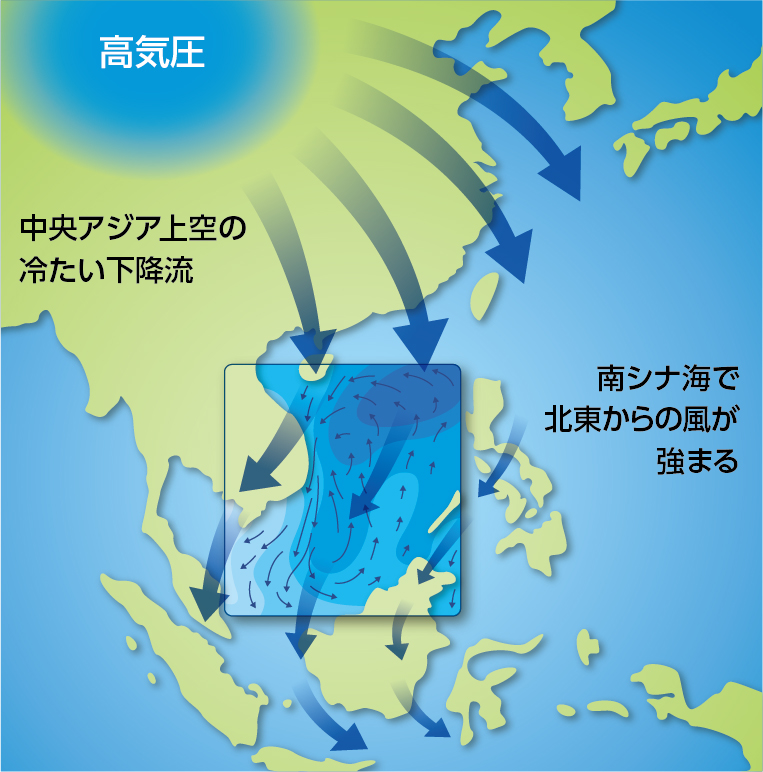2021年9月21日
南シナ海の低気圧性ジャイア
地球上の海には、「ジャイア」と呼ばれる大洋をぐるりと一周するような大きな渦が存在します。亜熱帯域のジャイアは、太陽からより多くの熱を受け取って水温の高い熱帯から高緯度へと熱を運ぶため、地球の気候にとって重要です。例えば、日本南岸を流れる黒潮は、太平洋の亜熱帯域におけるジャイアの西縁の海流です。この黒潮が、源流域のフィリピン近海から暖かい海水を輸送してくるため、日本南岸は緯度にしては海水温が比較的高くなっています。このようなジャイアは、季節によっては縁辺海(島や半島などによって囲まれ、部分的に閉じた大陸周辺の海)にも見られ、南シナ海では冬に低気圧性の反時計回りのジャイアが出現します(図1)。このジャイアはどのようにして形成され、なぜ冬のみに存在するのでしょうか?
その理由は、南シナ海の上を吹くモンスーンと呼ばれる季節風によって説明することができます。冬になると、シベリアからの寒気の吹き出しに伴い、南シナ海では、北東から南西に向かうモンスーンが吹きます(図1)。このモンスーンが、南シナ海の上で反時計回りに曲がるため、南シナ海に低気圧性の反時計回りのジャイアが形成されます。一方、夏になると、南シナ海は南西モンスーンの支配下になり、夏の強い日射で温められたアジア大陸に向かうような風が吹くようになります(図2)。この風が、南シナ海上で時計回りに曲がるため、南シナ海に冬とは逆で、高気圧性の時計回りのジャイアが形成されます。
このような縁辺海のジャイアは、大洋のジャイアに比べて空間的に小さく、長期的な地球温暖化の予測などを扱う気候モデルでは、解像度(前コラム参照)が粗すぎるため正確に再現するのが困難です。しかし、より解像度の高い気候モデルによるシミュレーションが可能になれば、南シナ海のような縁辺海のジャイアも現実的に再現できるようになり、周辺域の気候予測の精度も向上することが期待されます。


Gyres, which are large systems of circulating ocean currents or large “whirlpools”, are common across oceans on Earth. Gyres are important in controlling the climate by transporting heat from warm equatorial regions to cold polar regions. Gyres also exist in seas during a certain season, like the South China Sea winter cyclonic gyre (Figure 1). This cyclonic gyre is accompanied by the shallowing of sea level towards the center and cold deep water pumping upwards and spreading out at the surface. How does the winter cyclonic gyre form and why does it exist only during winter?
The prevailing wind or the monsoon explains that. During the winter, the cold air mass flows southward from Siberia, which generates the northeast monsoon over the South China Sea (Figure 1). During the winter, the winds will turn anti-clockwise or cyclonically over the South China Sea basin. These cyclonic winds flow over the basin and push the seawater, which results in cyclonic oceanic currents that are part of the cyclonic gyre. Conversely, during the summer, the South China Sea is influenced by the southwest monsoon, as air masses flow into warm central Asia continental landmass (Figure 2). Winds over the South China Sea would turn clockwise or anti-cyclonically, leading to anti-cyclonic oceanic currents. This explains why we do not see a cyclonic gyre during summer.
Gyres in seas are smaller than gyres in oceans. Currently, climate models are overcoming the challenge of reproducing small features. Improved climate models allow better representation of marginal sea gyres like the one in South China Sea, which in turn improves regional climate prediction.
研究参画者 Marvin Seow Xiang Ce
(日本語文作成:東塚知己)
東京大学 大学院理学系研究科




